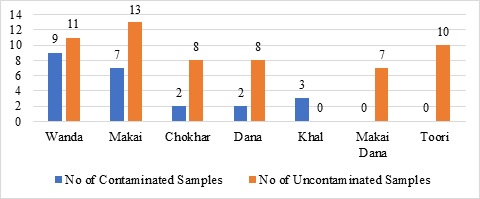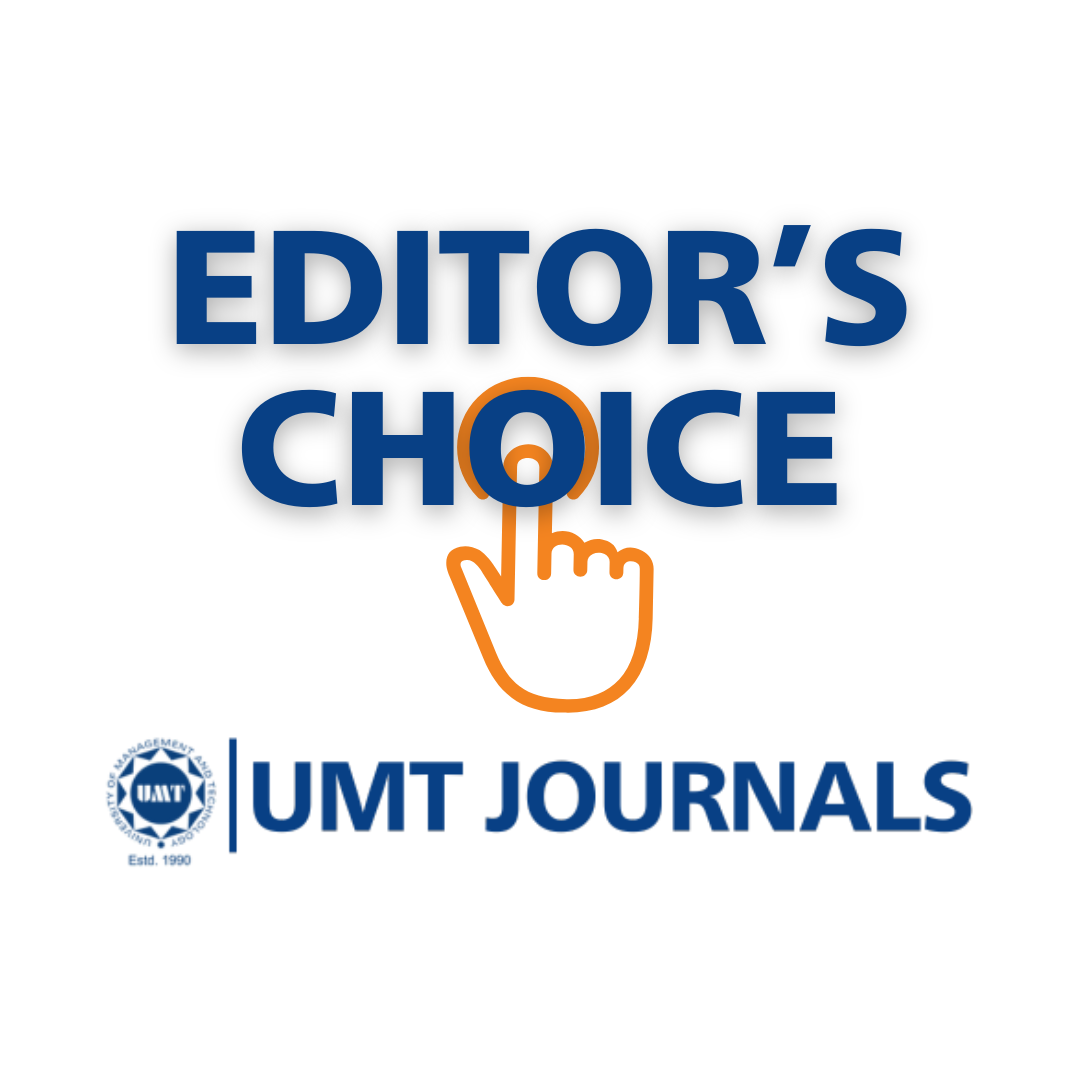Determination and Detoxification of Aflatoxins in Cattle Feed Samples Collected from Local Areas of Lahore, Pakistan
Abstract
 Abstract Views: 33
Abstract Views: 33
Aflatoxins are naturally occurring toxic metabolites produced by fungi in various food crops. The current study aims to determine the level of aflatoxins by using thin-layer chromatography in cattle feed samples and evaluates different methods including physical, chemical, and biological methods used for detoxification. A total of 80 samples including 40 fresh feed samples (20 wanda and 20 makai) and 40 dry feed samples (10 samples of dana, 10 samples of chokhar, 10 samples of toori, 3 samples of Khal, and 7 samples of makai dana) were collected from 22 areas of Lahore, Pakistan. Physical methods used for detoxification included washing and boiling, while chemical methods included detoxification with 10% citric acid, 10% acetic acid, 2% sodium hydroxide, and 2% hydrochloric acid. Finally, biological methods included detoxification with 0.15% mustard oil and 0.15% black seed oil. Among the samples, 9 wanda, 7 makai, 3 khal, 2 dana, and 2 chokhar samples were found to be contaminated. Only 6.25% of the samples exceeded the permissible limit of 20 parts per billion (ppb) set by the USFDA. A chemical method applied to khal samples achieved the highest reduction percentage at 63.64%. Meanwhile, physical and biological methods resulted in reduction percentages of 23.91% and 35.72%, respectively. These findings demonstrate the efficacy of various approaches, particularly highlighting the significant reduction achieved with the chemical method in khal samples. Moreover, these findings contribute to the understanding of effective strategies for mitigating aflatoxin contamination in cattle feed.
Downloads
References
Binder EM. Managing the risk of mycotoxins in modern feed production. Anim Feed Sci Technol. 2007;133(1 2):149–166. https://doi. org/10.1016/j.anifeedsci.2006. 08.008
Yitbarek MB, Tamir B. Mycotoxin and/or aflatoxins in milk and milk products [review]. Am Sci Res J Eng Technol Sci. 2014;4(1):1–32.
Filazi A, Sireli UT. Occurrence of aflatoxins in food. Aflatoxins recent advance and prospects. InTech. 2013:143–170. https://dx.doi.org/10. 5772/51301
Sengun I, Yaman DB, Gonul S. Mycotoxin and mold contamination in cheese: a review. World Mycotoxin J. 2008;1(3):291–298. https://doi.org/10. 3920/WMJ2008.x041
Hussain I. Aflatoxin measurement and analysis. In: Irineo Torres Pacheco, ed. Aflatoxins-Detection, Measurement and Control. InTech Open Access Publisher; 2011:130–146.
Kuilman MEM, Maas RFM, Fink-Gremmels J. Cytochrome P450-mediated metabolism and cytotoxicity of aflatoxin b1 in bovine hepatocytes. Toxicol Vitro. 2000;14(4):321–327. https://doi.org/10.1016/S08872333(00)00025-4
Kensler TW, Roebuck BD, Wogan GN, Groopman JD. Aflatoxin: a 50-year odyssey of mechanistic and translational toxicology. Toxicol Sci. 2011;120(suppl 1):S28–S48. https://doi.org/10.1093/toxsci/kfq283
Kim J, Park SH, Do KH, Kim D, Moon Y. Interference with mutagenic aflatoxin b1-induced checkpoints through antagonistic action of ochratoxin A in intestinal cancer cells: A molecular explanation on the potential risk of crosstalk between carcinogens. Oncotarget. 2016;7(26):39627–39639. https://doi. org/10.18632%2Foncotarget.8914
Makhlouf MMM. Histological and ultrastructural study of Aflatoxin B induces neurotoxicity in the sciatic nerve of adult male Albino rats. Ultrastruct Pathol. 2020;44(1):52–60. https://doi.org/10.1080/01913123.2019.1709933.
Ferreira RG, Cardoso MV, de Souza Furtado KM, Espíndola KMM, Amorim RP, Monteiro MC. Epigenetic alterations caused by aflatoxin b1: a public health risk in the induction of hepatocellular carcinoma. Transl Res. 2019;204:51–71. https://doi.org/10. 1016/j.trsl.2018.09.001
El Khoury D, Fayjaloun S, Nassar M, Sahakian J, Aad PY. Updates on the effect of mycotoxins on male reproductive efficiency in mammals. Toxins. 2019;11(9):e515. https://doi. org/10.3390/toxins11090515
Chen C, Mitchell NJ, Gratz J, et al. Exposure to aflatoxin and fumonisin in children at risk for growth impairment in rural Tanzania. Environ Int. 2018;115:29–37. https://doi.org/10. 1016/j.envint.2018.03.001
Richard JL. Some major mycotoxins and their mycotoxicosis—an overview. Int J Food Microbiol. 2007;119(1-2):3–10. https://doi.org/10.1016/ j.ijfoodmicro.2007.07.019
Prandini A, Tansini G, Sigolo S, Filippi L, Laporta M, Piva G. On the occurrence of aflatoxin M1 in milk and dairy products. Food Chem Toxicol. 2009;47(5):984–991. https://doi.org/ 10.1016/j.fct.2007.10.005.
Markov K, Pleadin J, Bevardi M, Vahčić N, Sokolić-Mihalak D, Frece J. Natural occurrence of aflatoxin b1, ochratoxin A and citrinin in Croatian fermented meat products. Food Control. 2013;34(2):312–317. https://doi.org/10.1016/j.foodcont.2013.05.002.
Saeed M, Iqbal M, Nadeem M, Ahmed A. Aflatoxin contamination in feed and milk of dairy animals in Pakistan. J Anim Plant Sci. 2020;30(1):253–259.
FAO F. A History of Farming Systems Research. London,UK: Food and Agriculture Organization of the United Nations (FAO) & CABI Publishing;2018.
Peña-Rodas O, Martinez-Lopez R, Hernandez-Rauda R. Occurrence of aflatoxin M1 in cow milk in El Salvador: results from a two-year survey. Toxicol Rep. 2018;5:671–678. https://doi.org/10.1016/j.toxrep.2018.06.004
Gutleb AC, Caloni F, Giraud F, et al. Detection of multiple mycotoxin occurrences in soy animal feed by traditional mycological identification combined with molecular species identification. Toxicol Rep. 2015;2:275–279. https://doi.org/10. 1016/j.toxrep.2015.01.006.
Khan MA, Asghar MA, Iqbal J, Ahmed A, Shamsuddin ZA. Aflatoxins contamination and prevention in red chillies (Capsicum annuum L.) in Pakistan. Food Addit Contam:Part B. 2014:7(1):1–6. https://doi.org/10. 1080/19393210.2013.825330
Zahra N, Jamil N, et al. Ochratoxin contamination of corn and applied detoxification approaches: a case study from Punjab Pakistan. Pak J Agri Sci. 2020:57(5):1345–1352. https://doi.org /10.21162/PAKJAS/20.9856
Van der Fels-Klerx HJ, Camenzuli L. Effects of milk yield, feed composition, and feed contamination with aflatoxin b1 on the aflatoxin M1 concentration in dairy cows’ milk investigated using Monte Carlo simulation modeling. Toxins. 2016;8(10):e290. https://doi.org/10. 3390/toxins8100290
Van der Fels-Klerx HJ, Bouzembrak Y. Modelling approach to limit aflatoxin b1 contamination in dairy cattle compound feed. World Mycotoxin J. 2016;9(3):455–464. https://doi.org/10. 3920/WMJ2015.1957
Costamagna D, Gaggiotti M, Chiericatti CA, et al. Quantification of aflatoxin M1 carry-over rate from feed to the soft cheese. Toxicol Rep. 2019;6:782–787. https://doi.org/10. 1016/j.toxrep.2019.07.004
Nazir A, Kalim I, Imran M, et al. Incidences and bio-detoxification of aflatoxins in rice and cattle feed crops under different agroecological zones. Pol J Environ Stud. 2021;30(2):1949–1954. https://doi.org/10.15244/pjoes /121050
Omeiza GK, Kabir J, Kwaga JKP, Kwanashie CN, Mwanza M, Ngoma L. A risk assessment study of the occurrence and distribution of aflatoxigenic Aspergillus flavus and aflatoxin b1 in dairy cattle feeds in a central northern state, Nigeria. Toxicol Rep. 2018;5:846–856. https://doi.org /10.1016/j.toxrep.2018.08.011
Pleadin J, Vulić A, Perši N, Škrivanko M, Capek B, Cvetnić Ž. Annual and regional variations of aflatoxin b1 levels were seen in grains and feed coming from Croatian dairy farms 5-year period. Food Control. 2015;47:221–225. https://doi.org /10.1016/j.foodcont.2014.07.017
Sadeeq ET. Some mycotoxins contamination in animal feed and feedstuff ingredients in Duhok province. J Univ Duhok. 2020;23(2):182–188.
Ramesh J, Ghadevaru S, Sureshkumar V. Analysis of feed samples for aflatoxin b1 contamination by HPTLC-a validated method. Int J Curr Microbiol Appl Sci. 2013;2(5):373–377.
Kotinagu K, Mohanamba T, Kumari LR. Assessment of aflatoxin b1 in livestock feed and feed ingredients by high-performance thin layer chromatography. Vet World. 2015;8(12):1396–1399. https://doi.org /10.14202%2Fvetworld.2015.1396-1399
Shad ZM, Ghavami M, Atungulu GG. Occurrence of aflatoxin in dairy cow feed ingredients and total mixed ration. Appl Eng Agric. 2019;35(5):679–686. https://doi.org/10.13031/aea.13454
Rodríguez-Blanco M, Ramos AJ, Prim M, Sanchis V, Marín S. Usefulness of the analytical control of aflatoxins in feedstuffs for dairy cows for the prevention of aflatoxin M 1 in milk. Mycotoxin Res. 2020;36(1):11–22. https://doi.org/10.1007/s12550-019-00362-y
Safara M, Zaini F, Hashemi SJ, Mahmoudi M, Khosravi AR, Shojai-Aliabadi F. Aflatoxin detoxification in rice using citric acid. Iran J Public Health. 2010;39(2):24–29.
Karlovsky P, Suman M, Berthiller F, et al. Impact of food processing and detoxification treatments on mycotoxin contamination. Mycotoxin Res. 2016;32(4):179–205. https://doi.org/10.1007/s12550-016-0257-7
Cai M, Qian Y, Chen N, et al. Detoxification of aflatoxin b1 by Stenotrophomonas sp. CW117 and characterization of the thermophilic degradation process. Environ Pollut. 2020;261:e114178. https://doi.org/10.1016/j.envpol.2020.114178
Khosravi AR, Minooeianhaghighi MH, Shokri H, Emami SA, Alavi SM, Asili J. The potential inhibitory effect of Cuminum cyminum, Ziziphora clinopodioides, and Nigella sativa essential oils on the growth of Aspergillus fumigatus and Aspergillus flavus. Braz J Microbiol. 2011;42(1):216–224. https://doi.org/10.1590/S1517-83822011000100027
Saladino F, Luz C, Manyes L, Fernández-Franzón M, Meca G. In vitro antifungal activity of lactic acid bacteria against mycotoxigenic fungi and their application in loaf breads shelf-life improvement. Food Control. 2016;67:273–277. https://doi.org/10. 1016/j.foodcont.2016.03.012
Nazir A, Kalim I, Sajjad M, Usman M, Iqbal M. Prevalence of aflatoxin contamination in pulses and spices in different regions of Punjab. Chem Int. 2019;5(4):274–280. https://doi.org/10. 5281/zenodo.3339415

Copyright (c) 2023 Hafiza Akifa Naeem, Aqeela Ashraf, Uzma Rafi, Naseem Zahra

This work is licensed under a Creative Commons Attribution 4.0 International License.
BSR follows an open-access publishing policy and full text of all published articles is available free, immediately upon publication of an issue. The journal’s contents are published and distributed under the terms of the Creative Commons Attribution 4.0 International (CC-BY 4.0) license. Thus, the work submitted to the journal implies that it is original, unpublished work of the authors (neither published previously nor accepted/under consideration for publication elsewhere). On acceptance of a manuscript for publication, a corresponding author on the behalf of all co-authors of the manuscript will sign and submit a completed the Copyright and Author Consent Form.









